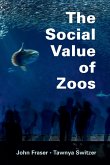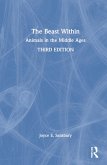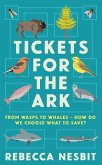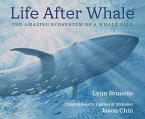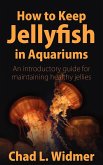Scientific Foundations of Zoos and Aquariums
Herausgeber: Kaufman, Allison B.; Maple, Terry L.; Bashaw, Meredith J.
Scientific Foundations of Zoos and Aquariums
Herausgeber: Kaufman, Allison B.; Maple, Terry L.; Bashaw, Meredith J.
- Broschiertes Buch
- Merkliste
- Auf die Merkliste
- Bewerten Bewerten
- Teilen
- Produkt teilen
- Produkterinnerung
- Produkterinnerung
Accredited zoos and aquariums worldwide conduct groundbreaking animal research. This book explores the breadth and impact of zoo programs and facilitates communication by sharing first-person tales of field and lab work. It also features conservation approaches in projects ranging from community education to population growth to rehabilitation.
Andere Kunden interessierten sich auch für
![The Social Value of Zoos The Social Value of Zoos]() John FraserThe Social Value of Zoos42,99 €
John FraserThe Social Value of Zoos42,99 €![Examining Ecology Examining Ecology]() Paul A. ReesExamining Ecology46,99 €
Paul A. ReesExamining Ecology46,99 €![The Beast Within The Beast Within]() Joyce E. Salisbury (Professor Emeritus of History at the UniversityThe Beast Within179,99 €
Joyce E. Salisbury (Professor Emeritus of History at the UniversityThe Beast Within179,99 €![Tickets for the Ark Tickets for the Ark]() Rebecca NesbitTickets for the Ark21,99 €
Rebecca NesbitTickets for the Ark21,99 €![Life After Whale Life After Whale]() Lynn BrunelleLife After Whale15,99 €
Lynn BrunelleLife After Whale15,99 €![How to Keep Jellyfish in Aquariums How to Keep Jellyfish in Aquariums]() Chad L WidmerHow to Keep Jellyfish in Aquariums21,99 €
Chad L WidmerHow to Keep Jellyfish in Aquariums21,99 €![Code Name Bananas Code Name Bananas]() David WalliamsCode Name Bananas7,49 €
David WalliamsCode Name Bananas7,49 €-
-
-
Accredited zoos and aquariums worldwide conduct groundbreaking animal research. This book explores the breadth and impact of zoo programs and facilitates communication by sharing first-person tales of field and lab work. It also features conservation approaches in projects ranging from community education to population growth to rehabilitation.
Produktdetails
- Produktdetails
- Verlag: Cambridge University Press
- Seitenzahl: 688
- Erscheinungstermin: 22. März 2019
- Englisch
- Abmessung: 229mm x 152mm x 37mm
- Gewicht: 1108g
- ISBN-13: 9781316648650
- ISBN-10: 1316648656
- Artikelnr.: 53166568
- Herstellerkennzeichnung
- Libri GmbH
- Europaallee 1
- 36244 Bad Hersfeld
- gpsr@libri.de
- Verlag: Cambridge University Press
- Seitenzahl: 688
- Erscheinungstermin: 22. März 2019
- Englisch
- Abmessung: 229mm x 152mm x 37mm
- Gewicht: 1108g
- ISBN-13: 9781316648650
- ISBN-10: 1316648656
- Artikelnr.: 53166568
- Herstellerkennzeichnung
- Libri GmbH
- Europaallee 1
- 36244 Bad Hersfeld
- gpsr@libri.de
Introduction Michael Hutchins, Robert J. Wiese and Brandie Smith; Part I.
Programs and Initiatives: 1. Evolving approaches to zoo-based conservation
Corinne J. Kendall and Richard A. Bergl; 2. Protecting an underwater
rainforest: freshwater science in the Southeastern United States Anna L.
George, Joshua R. Ennen and Bernard R. Kuhajda; 3. Headstarting as a
conservation strategy for threatened and endangered species Patrick Thomas,
Donal M. Boyer, David A. Oehler, Scott Silver and Lou Perrotti; 4.
Strategic gene banking for conservation: the ins and outs of a living bank
Rebecca J. Hobbs, Justine K. O'Brien and Rebecca E. Spindler; 5. The
environmental education program at São Paulo Zoo (Brazil): perspectives and
experiences for wildlife conservation Kátia Gisele de Oliveira Rancura,
Camila Martins and João Batista da Cruz; 6. Conservation and education
through dolphin research and eco-tourism Kathleen Dudzinski and Mary Ellen
Mateleska; Part II. Captive Care and Management: 7. Lear¿s macaw,
Anodorhynchus leari, ex situ breeding program at São Paulo Zoo Fernanda
Junqueira Vaz Guida, Regiane Vieira de Paiva Morais and Angélica Midori
Sugieda; 8. Measuring welfare through behavioral observation and adjusting
it with dynamic environments Jason V. Watters, Bethany L. Krebs and Eridia
Pacheco; 9. Empowering zoo animals Stephanie M. Allard and Meredith J.
Bashaw; 10. Transforming the nutrition of zoo primates (or how we became
known as Loris Man and that Evil Banana Woman) Amy Plowman and Francis
Cabana; 11. Tough questions, complex answers: American zookeeper responses
in a nationwide survey about culling David M. Powell and Matt Ardaiolo;
Part III. Saving Species: 12. Fly away home: a collaborative program to
return rehabilitated black cockatoos to the wild in Western Australia Anna
Le Souëf, Simone Vitali, Rick Dawson, Jill M. Shephard and Kristin S.
Warren; 13. Back into European wildlife: the reintroduction of the northern
bald ibis (Geronticus eremita) Johannes Fritz, Markus Unsöld and Bernhard
Völkl; 14. The thin green line: medical considerations in fighting
extinction of the Houston toad Lauren L. Howard and Paul S. Crump; 15.
Condor conservation comes home to roost: the Santa Barbara Zoo's story
Estelle A. Sandhaus and Rich Block; 16. Saving the black-footed ferret from
extinction: in theory and practice Rachel Santymire; Part IV. Basic
Research: 17. 'Largest breeding colony outside of Australia': linking koala
ex situ and in situ research Jennifer R. Tobey; 18. Comparative cognition
research in zoos Bonnie M. Perdue; 19. Learning about dolphins: an era of
discovery in managed care Holli C. Eskelinen, Jill L. Richardson and Kelley
A. Winship; 20. Contributions of zoo-based reproductive research to marine
animal conservation Justine K. O'Brien, Karen J. Steinman, Gisele A.
Montano and Todd R. Robeck; 21. Studying play in zoos and aquariums Sabrina
I. C. A. Brando and Gordon M. Burghardt; 22. Krogh's principle and why the
modern zoo is important to academic research Joseph R. Mendelson, III,
Gordon W. Schuett and Dwight P. Lawson; 23. Does research have a place in
the zoological garden? Terry L. Maple and Sally L. Sherwen; 24. Conclusion:
cultivating science in world zoos and aquariums Meredith J. Bashaw and
Terry L. Maple.
Programs and Initiatives: 1. Evolving approaches to zoo-based conservation
Corinne J. Kendall and Richard A. Bergl; 2. Protecting an underwater
rainforest: freshwater science in the Southeastern United States Anna L.
George, Joshua R. Ennen and Bernard R. Kuhajda; 3. Headstarting as a
conservation strategy for threatened and endangered species Patrick Thomas,
Donal M. Boyer, David A. Oehler, Scott Silver and Lou Perrotti; 4.
Strategic gene banking for conservation: the ins and outs of a living bank
Rebecca J. Hobbs, Justine K. O'Brien and Rebecca E. Spindler; 5. The
environmental education program at São Paulo Zoo (Brazil): perspectives and
experiences for wildlife conservation Kátia Gisele de Oliveira Rancura,
Camila Martins and João Batista da Cruz; 6. Conservation and education
through dolphin research and eco-tourism Kathleen Dudzinski and Mary Ellen
Mateleska; Part II. Captive Care and Management: 7. Lear¿s macaw,
Anodorhynchus leari, ex situ breeding program at São Paulo Zoo Fernanda
Junqueira Vaz Guida, Regiane Vieira de Paiva Morais and Angélica Midori
Sugieda; 8. Measuring welfare through behavioral observation and adjusting
it with dynamic environments Jason V. Watters, Bethany L. Krebs and Eridia
Pacheco; 9. Empowering zoo animals Stephanie M. Allard and Meredith J.
Bashaw; 10. Transforming the nutrition of zoo primates (or how we became
known as Loris Man and that Evil Banana Woman) Amy Plowman and Francis
Cabana; 11. Tough questions, complex answers: American zookeeper responses
in a nationwide survey about culling David M. Powell and Matt Ardaiolo;
Part III. Saving Species: 12. Fly away home: a collaborative program to
return rehabilitated black cockatoos to the wild in Western Australia Anna
Le Souëf, Simone Vitali, Rick Dawson, Jill M. Shephard and Kristin S.
Warren; 13. Back into European wildlife: the reintroduction of the northern
bald ibis (Geronticus eremita) Johannes Fritz, Markus Unsöld and Bernhard
Völkl; 14. The thin green line: medical considerations in fighting
extinction of the Houston toad Lauren L. Howard and Paul S. Crump; 15.
Condor conservation comes home to roost: the Santa Barbara Zoo's story
Estelle A. Sandhaus and Rich Block; 16. Saving the black-footed ferret from
extinction: in theory and practice Rachel Santymire; Part IV. Basic
Research: 17. 'Largest breeding colony outside of Australia': linking koala
ex situ and in situ research Jennifer R. Tobey; 18. Comparative cognition
research in zoos Bonnie M. Perdue; 19. Learning about dolphins: an era of
discovery in managed care Holli C. Eskelinen, Jill L. Richardson and Kelley
A. Winship; 20. Contributions of zoo-based reproductive research to marine
animal conservation Justine K. O'Brien, Karen J. Steinman, Gisele A.
Montano and Todd R. Robeck; 21. Studying play in zoos and aquariums Sabrina
I. C. A. Brando and Gordon M. Burghardt; 22. Krogh's principle and why the
modern zoo is important to academic research Joseph R. Mendelson, III,
Gordon W. Schuett and Dwight P. Lawson; 23. Does research have a place in
the zoological garden? Terry L. Maple and Sally L. Sherwen; 24. Conclusion:
cultivating science in world zoos and aquariums Meredith J. Bashaw and
Terry L. Maple.
Introduction Michael Hutchins, Robert J. Wiese and Brandie Smith; Part I.
Programs and Initiatives: 1. Evolving approaches to zoo-based conservation
Corinne J. Kendall and Richard A. Bergl; 2. Protecting an underwater
rainforest: freshwater science in the Southeastern United States Anna L.
George, Joshua R. Ennen and Bernard R. Kuhajda; 3. Headstarting as a
conservation strategy for threatened and endangered species Patrick Thomas,
Donal M. Boyer, David A. Oehler, Scott Silver and Lou Perrotti; 4.
Strategic gene banking for conservation: the ins and outs of a living bank
Rebecca J. Hobbs, Justine K. O'Brien and Rebecca E. Spindler; 5. The
environmental education program at São Paulo Zoo (Brazil): perspectives and
experiences for wildlife conservation Kátia Gisele de Oliveira Rancura,
Camila Martins and João Batista da Cruz; 6. Conservation and education
through dolphin research and eco-tourism Kathleen Dudzinski and Mary Ellen
Mateleska; Part II. Captive Care and Management: 7. Lear¿s macaw,
Anodorhynchus leari, ex situ breeding program at São Paulo Zoo Fernanda
Junqueira Vaz Guida, Regiane Vieira de Paiva Morais and Angélica Midori
Sugieda; 8. Measuring welfare through behavioral observation and adjusting
it with dynamic environments Jason V. Watters, Bethany L. Krebs and Eridia
Pacheco; 9. Empowering zoo animals Stephanie M. Allard and Meredith J.
Bashaw; 10. Transforming the nutrition of zoo primates (or how we became
known as Loris Man and that Evil Banana Woman) Amy Plowman and Francis
Cabana; 11. Tough questions, complex answers: American zookeeper responses
in a nationwide survey about culling David M. Powell and Matt Ardaiolo;
Part III. Saving Species: 12. Fly away home: a collaborative program to
return rehabilitated black cockatoos to the wild in Western Australia Anna
Le Souëf, Simone Vitali, Rick Dawson, Jill M. Shephard and Kristin S.
Warren; 13. Back into European wildlife: the reintroduction of the northern
bald ibis (Geronticus eremita) Johannes Fritz, Markus Unsöld and Bernhard
Völkl; 14. The thin green line: medical considerations in fighting
extinction of the Houston toad Lauren L. Howard and Paul S. Crump; 15.
Condor conservation comes home to roost: the Santa Barbara Zoo's story
Estelle A. Sandhaus and Rich Block; 16. Saving the black-footed ferret from
extinction: in theory and practice Rachel Santymire; Part IV. Basic
Research: 17. 'Largest breeding colony outside of Australia': linking koala
ex situ and in situ research Jennifer R. Tobey; 18. Comparative cognition
research in zoos Bonnie M. Perdue; 19. Learning about dolphins: an era of
discovery in managed care Holli C. Eskelinen, Jill L. Richardson and Kelley
A. Winship; 20. Contributions of zoo-based reproductive research to marine
animal conservation Justine K. O'Brien, Karen J. Steinman, Gisele A.
Montano and Todd R. Robeck; 21. Studying play in zoos and aquariums Sabrina
I. C. A. Brando and Gordon M. Burghardt; 22. Krogh's principle and why the
modern zoo is important to academic research Joseph R. Mendelson, III,
Gordon W. Schuett and Dwight P. Lawson; 23. Does research have a place in
the zoological garden? Terry L. Maple and Sally L. Sherwen; 24. Conclusion:
cultivating science in world zoos and aquariums Meredith J. Bashaw and
Terry L. Maple.
Programs and Initiatives: 1. Evolving approaches to zoo-based conservation
Corinne J. Kendall and Richard A. Bergl; 2. Protecting an underwater
rainforest: freshwater science in the Southeastern United States Anna L.
George, Joshua R. Ennen and Bernard R. Kuhajda; 3. Headstarting as a
conservation strategy for threatened and endangered species Patrick Thomas,
Donal M. Boyer, David A. Oehler, Scott Silver and Lou Perrotti; 4.
Strategic gene banking for conservation: the ins and outs of a living bank
Rebecca J. Hobbs, Justine K. O'Brien and Rebecca E. Spindler; 5. The
environmental education program at São Paulo Zoo (Brazil): perspectives and
experiences for wildlife conservation Kátia Gisele de Oliveira Rancura,
Camila Martins and João Batista da Cruz; 6. Conservation and education
through dolphin research and eco-tourism Kathleen Dudzinski and Mary Ellen
Mateleska; Part II. Captive Care and Management: 7. Lear¿s macaw,
Anodorhynchus leari, ex situ breeding program at São Paulo Zoo Fernanda
Junqueira Vaz Guida, Regiane Vieira de Paiva Morais and Angélica Midori
Sugieda; 8. Measuring welfare through behavioral observation and adjusting
it with dynamic environments Jason V. Watters, Bethany L. Krebs and Eridia
Pacheco; 9. Empowering zoo animals Stephanie M. Allard and Meredith J.
Bashaw; 10. Transforming the nutrition of zoo primates (or how we became
known as Loris Man and that Evil Banana Woman) Amy Plowman and Francis
Cabana; 11. Tough questions, complex answers: American zookeeper responses
in a nationwide survey about culling David M. Powell and Matt Ardaiolo;
Part III. Saving Species: 12. Fly away home: a collaborative program to
return rehabilitated black cockatoos to the wild in Western Australia Anna
Le Souëf, Simone Vitali, Rick Dawson, Jill M. Shephard and Kristin S.
Warren; 13. Back into European wildlife: the reintroduction of the northern
bald ibis (Geronticus eremita) Johannes Fritz, Markus Unsöld and Bernhard
Völkl; 14. The thin green line: medical considerations in fighting
extinction of the Houston toad Lauren L. Howard and Paul S. Crump; 15.
Condor conservation comes home to roost: the Santa Barbara Zoo's story
Estelle A. Sandhaus and Rich Block; 16. Saving the black-footed ferret from
extinction: in theory and practice Rachel Santymire; Part IV. Basic
Research: 17. 'Largest breeding colony outside of Australia': linking koala
ex situ and in situ research Jennifer R. Tobey; 18. Comparative cognition
research in zoos Bonnie M. Perdue; 19. Learning about dolphins: an era of
discovery in managed care Holli C. Eskelinen, Jill L. Richardson and Kelley
A. Winship; 20. Contributions of zoo-based reproductive research to marine
animal conservation Justine K. O'Brien, Karen J. Steinman, Gisele A.
Montano and Todd R. Robeck; 21. Studying play in zoos and aquariums Sabrina
I. C. A. Brando and Gordon M. Burghardt; 22. Krogh's principle and why the
modern zoo is important to academic research Joseph R. Mendelson, III,
Gordon W. Schuett and Dwight P. Lawson; 23. Does research have a place in
the zoological garden? Terry L. Maple and Sally L. Sherwen; 24. Conclusion:
cultivating science in world zoos and aquariums Meredith J. Bashaw and
Terry L. Maple.


